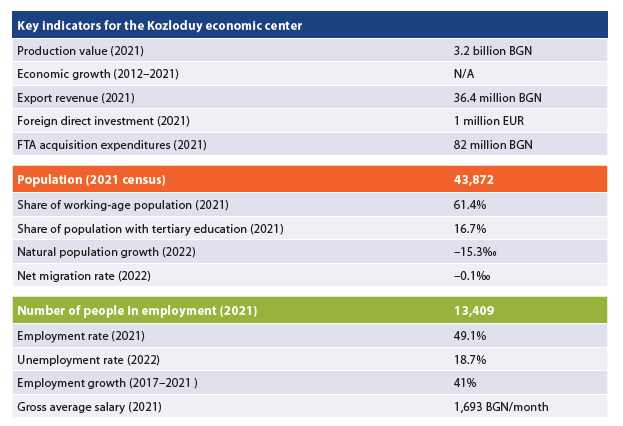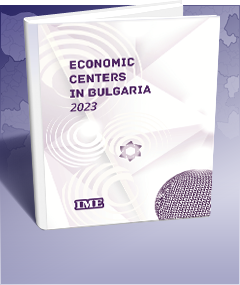Kozloduy Economic Centre
KOZLODUY ECONOMIC CENTER
- INTRODUCTION | Key indicators for the Kozloduy economic center


- COMPOSITION AND LABOR MIGRATION
The Kozloduy Centre is composed of Kozloduy municipality as its core and the neighboring municipalities of Hayredin, Mizia, Oryahovo and Valchedrum as its periphery. Compared to the previous edition of the study (2017), the center has expanded by adding Valchedrum. The daily labor migration from the four municipalities to the core exceeds 1,000 people, with the largest number from the Mizia municipality – almost 600 people, or 33% of all employees. There appears to be little potential for future expansion of the center, as outside of these municipalities the highest proportion of incoming workers to Kozloduy are from Byala Slatina – 3.8% of all its employees.
- ECONOMY AND INVESTMENT
In 2021, production value in the Kozloduy Economic center reached 3.2 billion BGN, or 72,900 BGN per capita – the highest value of this indicator in the whole country. This reflects mostly the atypical structure of the local economy, in which almost all the value added is created by the production of electricity at the Kozloduy NPP. Outside the core, the largest peripheral economy is that of Valchedrum, with agriculture being the leading sector in all four municipalities, generating more than half of the value added. Besides the nuclear power plant, which in 2021 had 3,700 workers and 2.7 billion BGN in revenue, and its affiliated company Atomenergoremont which employs another 814 people, larger employers include the general hospital in Kozloduy, as well as several industrial enterprises and agricultural producers.
Foreign investment is practically absent in the economic center, according to NSI non-confidential data. Investment activity in 2021 was also relatively weak, with total expenditure on FTA acquisition in that year amounting to 82 million BGN – the lowest value among all the 16 economic centers of the country. Expenditures for the purchase of machinery, land and buildings were distributed relatively evenly, with 31 million BGN in the Kozloduy municipality, 26 million BGN in Valchedrum, 11.5 million BGN in Mizia, and 10.3 million BGN in Oryahovo. Outside the core of the economic center, almost all investment is concentrated in the agricultural sector. The Kozloduy center has the lowest export earnings in the non-financial sector in 2021 – 36.4 million BGN. However, this does not include the electricity produced by the Kozloduy NPP and exported out of the country – if the nuclear plant was included in the accounts, the center would most likely be among the export leaders.
- LABOR MARKET
Against the backdrop of rapid recovery in all other centers, Kozloduy’s constituent municipalities still had very high unemployment in 2022. The center’s average is 18.7% of the population aged 15–64. In Kozloduy municipality the share of the unemployed is 9%, but in Hayredin it reaches 1/3 of the working-age population, and in Valchedrum it exceeds 30%. Unemployment problems appear to be structural, as most of the unemployed are in the group of the long-term unemployed registered in the labor offices for over a year: in Hayredin they are 19% of the working-age population, in Valchedrum – 16%, in the Kozloduy municipality – 3.5%. The center has significant problems with youth unemployment, too: the share of the unemployed among the population under the age of 29 exceeds 10% in most municipalities.
At the same time, the employment rate is the lowest among the economic centers at 49% according to 2021 Census data. Employment rates are significantly lower in the peripheral municipalities, with the lowest figure in Valchedrum – 38%, but even the core’s rate is not particularly high – 58%. Most employees are concentrated in the Kozloduy municipality – 7,000 people, with the leading sector being energy production and agriculture playing a major role in the peripheral municipalities. Over the last 5 years, the local labor market has been expanding, with the number of employed people increasing by 4.1%, compared to 2017.
The Kozloduy center has seen a moderate growth of 42% in average salaries over the last 5 years, to a gross average of 1,693 BGN per month, with only the center around the capital performing better on this indicator. Significantly higher are monthly salaries in Kozloduy municipality – 2,682 BGN in 2021, one of the highest municipal salary levels in the country.
- HUMAN RESOURCES AND WORKFORCE
 Between the last two censuses, the Kozloduy center recorded the fastest population decline among all the 16 economic centers in the country (–20.5% within the decade). With 44,000 residents, it is also the smallest center based on population, and 18 thousand of them are in the core. The center has a relatively low share of working-age (15–64) people – 61.4% or 27,000 people, with 12,000 of them in the Kozloduy municipality. Against this background, ageing indicators are not particularly unfavorable, especially compared to other parts of northwestern Bulgaria, as the share of the population over 65 is 24%, though in the peripheral municipalities it is significantly higher.
Between the last two censuses, the Kozloduy center recorded the fastest population decline among all the 16 economic centers in the country (–20.5% within the decade). With 44,000 residents, it is also the smallest center based on population, and 18 thousand of them are in the core. The center has a relatively low share of working-age (15–64) people – 61.4% or 27,000 people, with 12,000 of them in the Kozloduy municipality. Against this background, ageing indicators are not particularly unfavorable, especially compared to other parts of northwestern Bulgaria, as the share of the population over 65 is 24%, though in the peripheral municipalities it is significantly higher.
Kozloduy is one of the two centers in the country, alongside Sliven–Yambol, which are losing population as a result of migration processes, with a net migration rate of –0.1‰ in 2022. In fact, migration is relatively balanced, with some municipalities like Oryahovo and Mizia gaining population. However, the natural growth rate is highly negative, with a balance between mortality and birth rates of –15.3‰ on average for the center, though slightly higher in the core (–7.2‰). These indicators confirm the serious demographic obstacles to Kozloduy’s further economic development, especially outside the energy sector.
The educational structure of the center poses similar challenges. The share of university graduates among the population aged 7 and older is 16.7% – the lowest among all centers – and equal to that of Kardzhali. At the same time, 1/3 of the population has primary or lower education, and the illiteracy rate according to the 2021 census is 1.2%. The educational structure of the core is slightly more favorable, but even there the share of the poorly educated is high, and in the periphery, the share of university graduates is significantly lower than the average for the center. Students’ performance is not particularly promising, either, with the center recording the lowest scores in the NEA in mathematics at the end of grade 7, as well as some of the lowest matriculation examination scores in BLL in the country.
Latest news
Math talents on the edge of the map 30.06.2025
If you think that mathematics can only be taught and learned well in mathematics high schools or elite...
The municipalities need more own resources and a share of revenues from personal income taxation 26.06.2025
IME analysis shows opportunities for expanding municipalities' financial autonomy. The budget expenditures...
